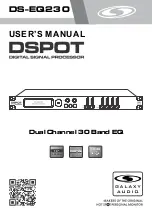
87
Omnia ONE AM
As of April 2008 – Version 2.1 AM Software
Note: Discrete I/O measurements have been made in "Bypass" mode (available in the
Input/Output menu).
Note: All measurements made with the supplied “FACT_TEST” preset, which is available in the
Preset Submenu.
System Frequency Response
Complie
s with the NRSC emphasis curve within ± 0.50 dB, 30 Hz to
10 kHz. (At a setting of “10” on the HF EQ control)
System Signal to Noise Ratio
-80 dB de-
emphasized, 20 Hz
–-
10 kHz NRSC bandwidth, referenced to
100% modulation).
*The measured noise floor will depend upon the settings of the Input and Output Gain controls and is primarily governed
by dynamic range of the Crystal Semiconductor CS5361 A/D Converter which is specified as >110 dB. The dynamic range
of the internal digital signal processing chain is >144 dB.
System Distortion
Less than 0.01% THD, 20 Hz
–
5 kHz. (second order harmonic
distortion above 5 kHz is not relevant in the AM system due to the
removal of harmonics by the system's 10 kHz low pass filter)
System Stereo Separation
Greater than 65 dB, 20 Hz
–-
10 kHz; greater than 70 dB typical.
Analog Audio Input:
Left/Right Stereo.
Electronically balanced.
Input impedance 10k ohms resistive.
Maximum Input Level: +22 dBu.
Nominal Input Level: +4dBu, which nets a -18d
BFS input meter reading
on a steady-state signal when the Input Gain control is set to 0.0dB.
Program material with a nominal average level (VU reading) of +4dBu
will typically produce peak readings on the input meter in the range of -12
dBFS to
-
6dBFS.
This is the correct operating level.
A/D Conversion:
Crystal Semiconductor CS5361, 24 bit 128x over-sampled delta sigma
converter with linear-phase anti-
aliasing filter. Pre
-
ADC anti
-alias filter,
with high-
pass filter at <10 Hz.
Connectors:
Two, EMI-
suppressed XLR
-
female. Pin 1 chassis ground, Pin 2 "Hot".
















































